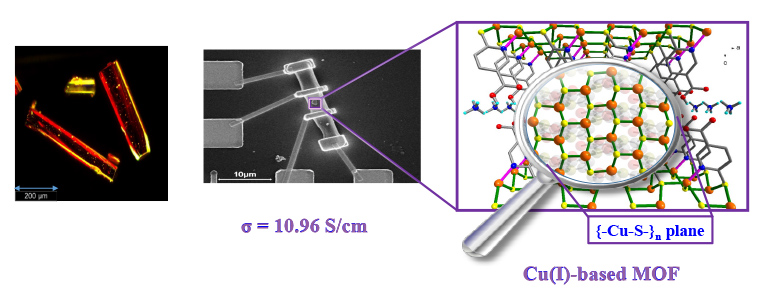Institute of Chemistry, Academia Sinica – Research
設計新型銅硫二維平面於金屬有機骨架聚合物實現高導電性
Integration of a (–Cu–S–)n plane in a metal–organic framework affords high electrical conductivityNat. Commun. 2019, 10, 1721.
Abhishek Pathak, Jing-Wen Shen, Muhammad Usman, Ling-Fang Wei, Shruti Mendiratta, Yu-Shin Chang, Batjargal Sainbileg, Chin-May Ngue, Ruei-San Chen, Michitoshi Hayashi, Tzuoo-Tsair Luo, Fu-Rong Chen, Kuei-Hsien Chen*, Tien-Wen Tseng*, Li-Chyong Chen* and Kuang-Lieh Lu*
當前綠能與儲能等研究領域中,設計高導電金屬有機骨架聚合物(MOF)是極具應用潛力的主題。本研究設計新型的銅硫(–Cu–S–)n二維平面於MOF結構,展現高導電MOF之特性。利用水熱法,合成MOF化合物{[Cu2(6-Hmna)(6-mn)]·NH4}n。經各種材料分析發現該化合物具(–Cu–S–)n二維平面結構、低活化能(6 meV)、小帶隙(1.34 eV)、及高電導率(10.96 S cm−1)等特性,適用於電池、熱電、超級電容器等相關領域。本研究是由中研院化學所呂光烈、中研院原分所陳貴賢、台大凝態科學中心林麗瓊與台北科大化工系曾添文等教授共同合作,以及台大凝態科學中心林倫年、台灣科大應用科技研究所陳瑞山與清大工程與系統科學系陳福榮等教授協同合作成果,論文已於近期發表於 Nature Communications 期刊 (2019, 10, 1721) 。

A new strategy for integrating a metal–sulfur plane within a MOF to achieve high electrical conductivity is reported. This successful design is significant for its potential applications in diverse areas encompassing energy storage and generation. Single crystals of a copper-based metal–organic framework consisting of 2D (–Cu–S–)n plane were synthesized by combining Cu(NO3)2 and 6,6ʹ-dithiodinicotinic acid via the in-situ cleavage of an S–S bond under hydrothermal conditions. This copper-based MOF was found to have a low activation energy (6 meV), small bandgap (1.34 eV) and a highest electrical conductivity (10.96 S cm−1) among MOFs for single crystal measurements. This study carried out by Kuang-Lieh Lu, Kuei-Hsien Chen, Li-Chyong Chen, Tien-Wen Tseng along with Michitoshi Hayashi, Ruei-San Chen, Fu-Rong Chen and their students provides an excellent example of interdisciplinary collaboration efforts. In addition, these results provide distinctive applications of highly conductive MOF in batteries, thermoelectric, supercapacitors and related areas.
